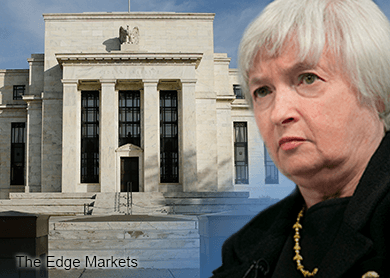
WASHINGTON (Mar 19): The Federal Reserve opened the door to the first interest-rate increase in almost a decade, while also indicating it will go slowly once it gets started.
The Fed dropped an assurance that it will be “patient” in tightening, ending an era of explicit guidance on the path of policy, and reduced its forecasts for the benchmark rate.
“Just because we removed the word patient from the statement doesn’t mean we are going to be impatient,” Chair Janet Yellen said in a press conference Wednesday in Washington. “This change does not mean an increase will necessarily occur in June, although we cannot rule that out.”
Stocks and Treasuries jumped on expectations that an exit from the most aggressive easing in the Fed’s 100-year history will be more gradual than previously anticipated. In a new set of quarterly projections, policy makers cut forecasts for economic growth and inflation.
“The combination of softer inflation, more labor market slack and a rising dollar means the tightening path is much shallower than it was before,” said Michael Gapen, chief U.S. economist for Barclays Plc in New York and former Fed Board economist. Gapen predicted a rate increase in September.
The Standard & Poor’s 500 Index rose 1.2 percent to 2,099.50 at the 4 p.m. close of trading in New York. Ten-year Treasury notes yielded 1.92 percent, down 13 basis points.
Guidance Shift
Dropping the pledge to be “patient” marks a shift away from the explicit guidance on the future path of policy that the Fed has used since late 2008 to keep longer-term borrowing costs low. Yellen stressed that policy makers will make decisions based on their latest assessment of the economic data.
She said it will be appropriate to raise rates “when the committee has seen further improvement in the labor market and is reasonably confident that inflation will move back to its 2 percent objective over the medium term.”
Fed officials confront conflicting signals from their dual mandates for full employment and price stability as they weigh when to tighten policy for the first time since June 2006.
Surging job gains pushed unemployment down to 5.5 percent in February, the lowest level in almost seven years, suggesting the economy is strong enough to withstand higher borrowing costs.
“We are seeing an economy that’s growing above trend,” Yellen said during her press conference. “The labor market is improving” and “some of the headwinds that have held the economy back are receding.”
Slack Remains
Inflation and wage growth also haven’t been as strong as many Fed officials would like, suggesting that there’s more slack left in the economy than low unemployment alone suggest.
“If we did see wage growth pick up, that would be at least a symptom that inflation would move up over time,” Yellen said. Still, she said faster wage growth isn’t a precondition for raising interest rates.
Prices as measured by the Fed’s preferred gauge rose just 0.2 percent in January from a year earlier, and inflation has languished below the central bank’s 2 percent goal for 33 straight months.
The Fed is preparing to tighten even as stagnant growth elsewhere prompts central banks in Europe, China and Japan to ease policy. That has put upward pressure on the dollar, which has jumped more than 4 percent since Fed policy makers last met on Jan. 28, posing a potential headwind to growth as American exports become more expensive.
In its statement, the FOMC said “export growth has weakened,” and Yellen said the strength of the dollar is one reason. She said the dollar’s gains, while reflecting the relative strength of the U.S. economy, will also hold down inflation.